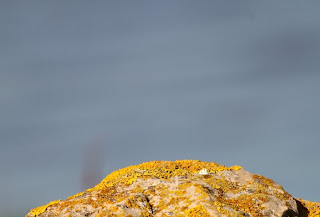I stepped out of my back door at 6am to another clear, cold and star filled morning with my warm breath condensing in the close to zero air. I jumped into the Suzuki, switched the heater to the “toast” setting, stuffed a pair of gloves into a warm air vent, flicked on the heated seat so as to warm my essential bits, then set off for Rawcliffe Moss.
It was still black when I met Will at 0630 but we set to in getting the nets up in the frost before the thrushes dropped in. In fact we were early enough to catch a few roosting Redwings in the first net as we toured the plantation erecting the remainder.
I’d said to Will that the first migrant Redwings arrived at 0740 on Saturday, exactly as they did today, on the dot, when a party of about 30 birds came from the south east and dived into the plantation. They brought with them a few Fieldfares. That was the opening shot of today’s thrush movement which from 0740 until about 1030am consisted of approximately 300 Redwing, 120 Fieldfare, 9 Song Thrush and 5 Blackbirds. About 50% of the thrushes arrived from the south-east this morning, travelling with the prevailing wing, whilst most others came from the north and north-west.
Our catch this morning was made up of 35 birds of 11 species, 33 new and 2 recaptures. 14 Redwing, 2 Song Thrush, 3 Fieldfare, 3 Goldfinch, 3 Chaffinch, 2 Great Tit, 1 Robin, 1 Yellowhammer and 4 Reed Bunting were new birds, while a Blackbird and a Coal Tit were ringed on site on previous occasions.





We are keeping an eye on the biometrics and adult/juvenile ratio of the Redwings caught so far this autumn and at the moment they split very nearly 50/50 adult/juvenile with consistent weights that vary between 54 and 64 grams. One adult today had a wing length of 125mm which could place it into the Icelandic origin bracket.
Other birds on the move this morning, c50/60 Chaffinch, 4+ Brambling, 12+ Siskin which included a party of eight, 4 Lesser Redpoll, 4 Stock Dove rapidly heading south, 1 Grey Wagtail, and 8+ alba Wagtails. Twice we noted groups of Jackdaws flying dead south both fast and low over the plantation and we totalled them to c80 birds. This was in total contrast to the hundreds of Jackdaws that at dawn noisily left the regular roost situated in a large wood on the next door farm and dispersed west to their daytime locations.
Waders this morning consisted of the usual several Snipe plus a lone Golden Plover fly over. Raptors noted this morning - a Sparrowhawk hunting through the plantation at dawn, a lone Kestrel, plus a dashing Merlin as we prepared to leave at 11am. But, where have all the Buzzards gone?

At dawn this morning the sky was awesomely red. I have not changed the photograph in any way except for sharpening. But later in the day the clouds rolled in to a BBC promise of rain on the way - “Red sky in the morning, shepherd’s warning”, or should that be “ringer’s warning”?






































































